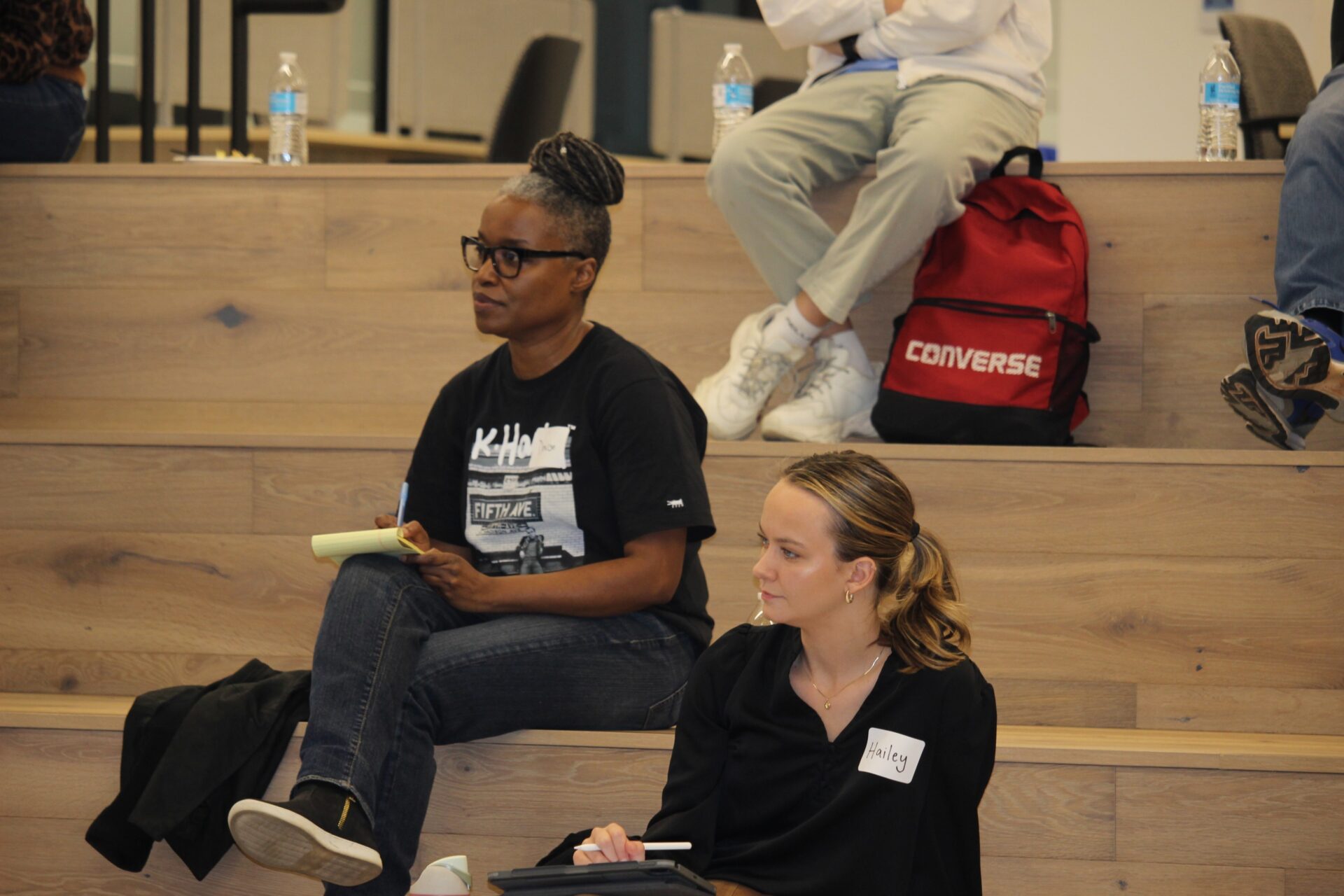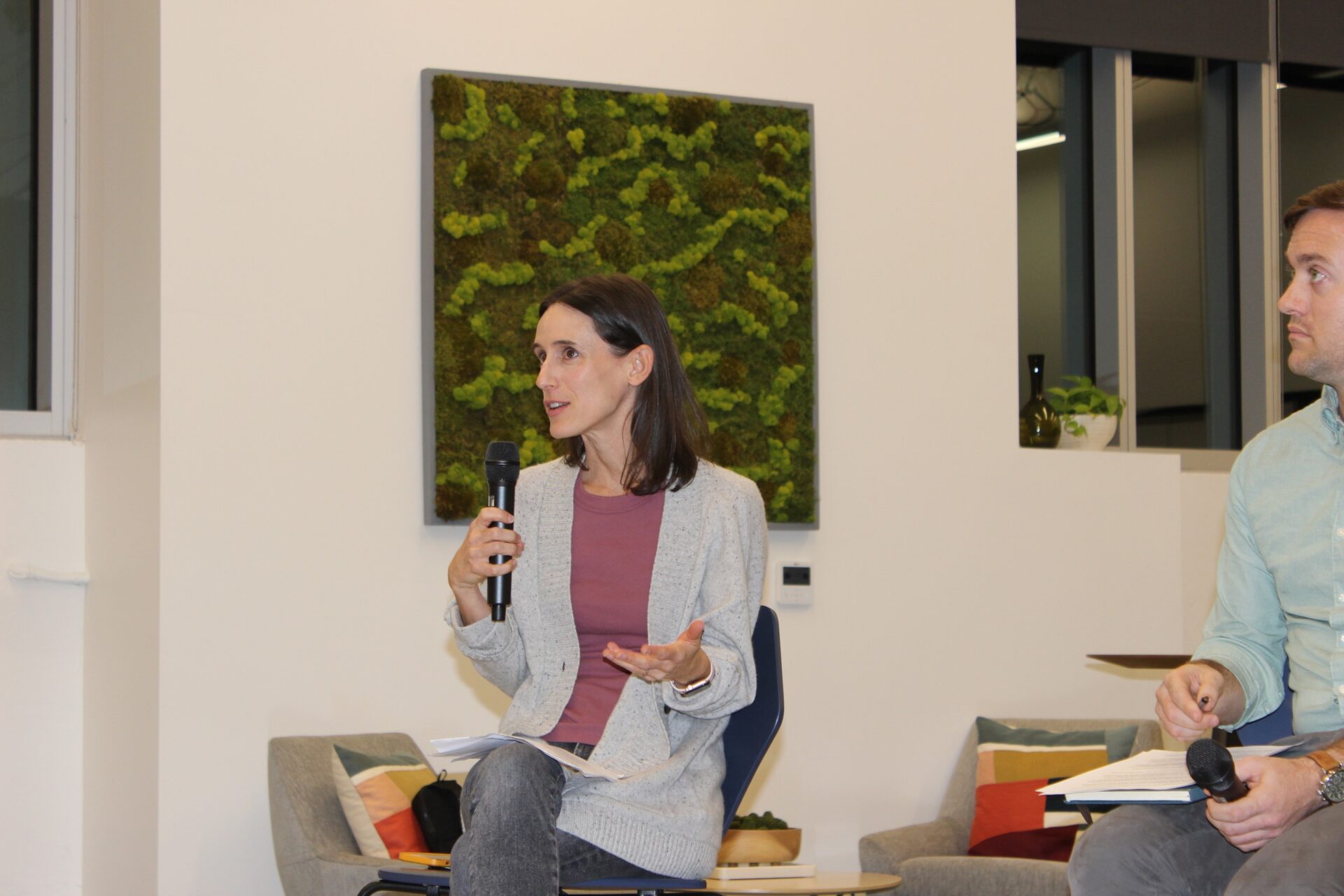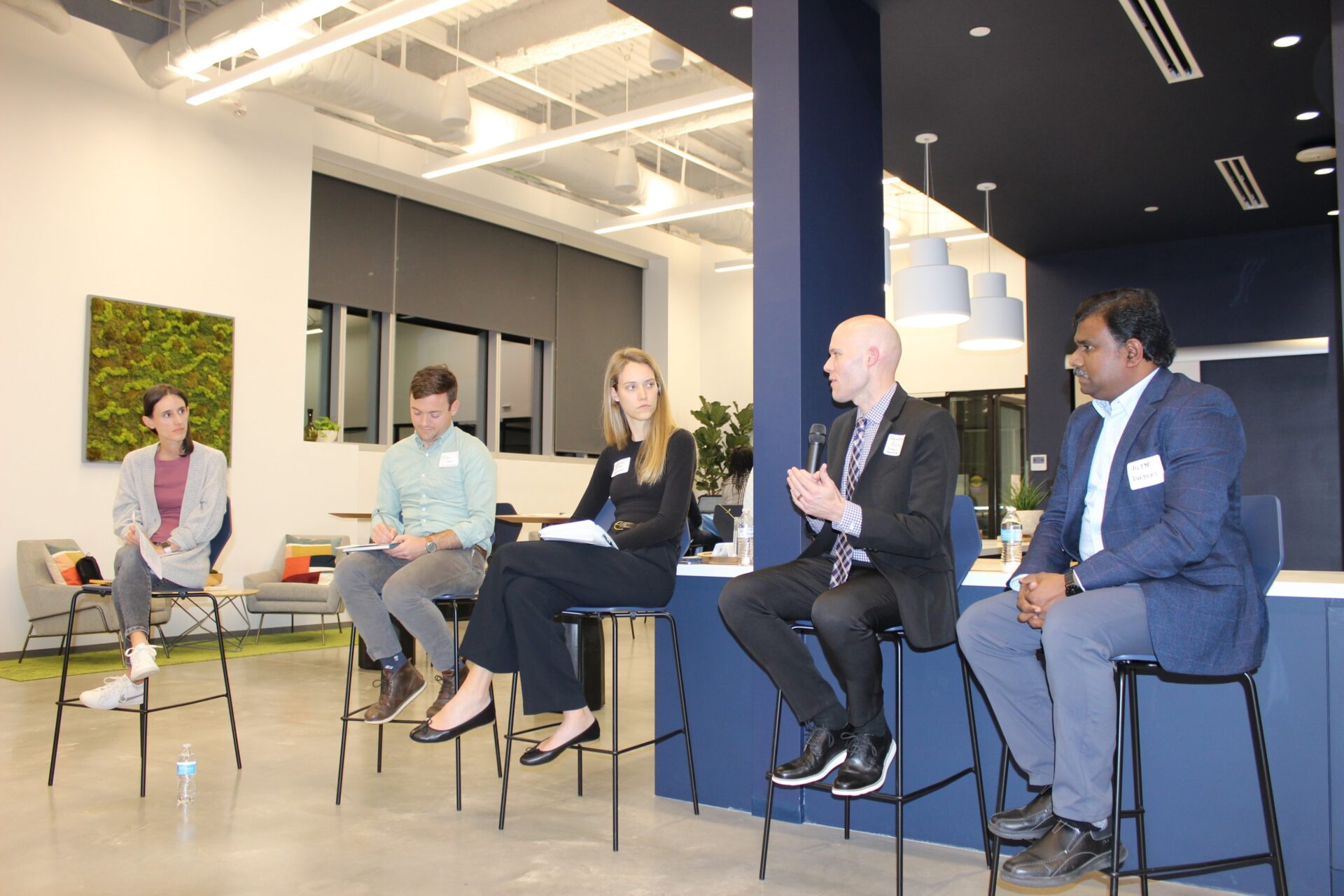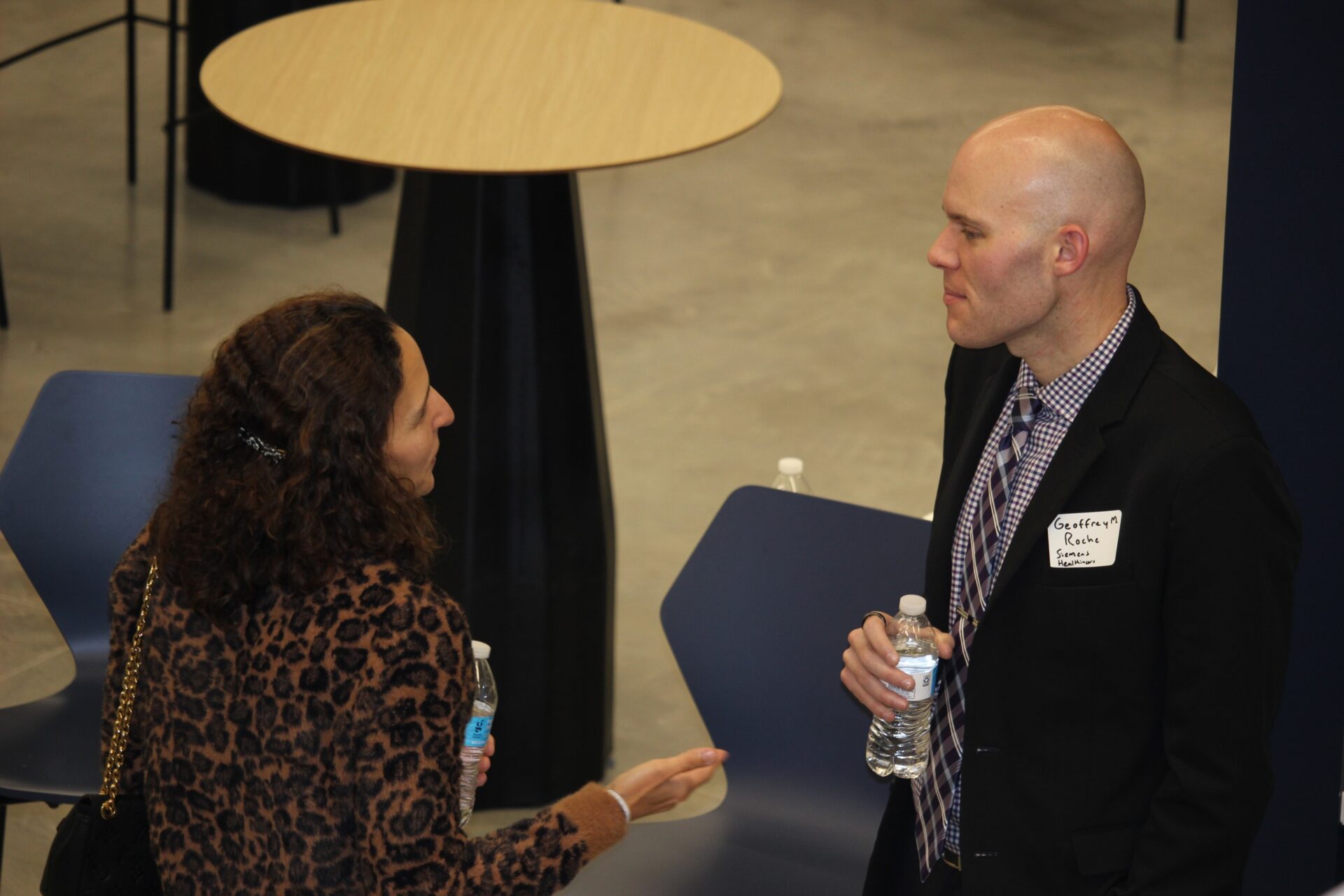

To thrive in the future of work, organizations and people across all industries will need to build skills for jobs that don’t yet exist. Continual learning, upskilling and reskilling will be the norm. What skills will employers look for? How can employees of today avoid professional skill extinction and transform themselves into the in-demand talent of tomorrow? And what steps should employers take now to start cultivating the talent they’ll need to compete in the years ahead?

In an innovation economy, change is ever present and escalating. The most valuable knowledge and skills of today may soon be relics of a past workforce, replaced by new roles and capabilities we haven’t fully imagined. To explore rapid shifts occurring in the workforce and strategies for preparing talent for the future of work, a panel of industry leaders convened at UNC-Chapel Hill’s Innovate Carolina Junction for a conversation titled “Future Proof: Innovation Skills of Tomorrow.” Panel moderator Ursula Mead, CEO and Founder of InHerSight, led an interactive discussion with other experts in the field, including:
In part one of their discussion, the group explored talent-related shifts in the workforce. Find out what they had to say about demographic and economic trends, the credentials employers want employees to have, current and future skills gaps, which skills will be most valuable, and the steps you can take now to prepare talent for the future of work. Want to learn more? Read part two of the discussion.
Michael Hogan: Based on workforce and business surveys in North Carolina over the last 10 years, we’ve looked at health care, local government, cybersecurity workforces and a number of different sectors. One thing that stands out is that four-year degrees are still highly valued, with one key caveat: employers are starting to look more for specialized skills. They want employees to have a “degree plus,” meaning a traditional degree, plus a specialized skill, certification or credential within their industry. This expectation is growing across different industries, whether it’s health care, tech, advanced manufacturing trades, energy, etc. These industries are rapidly incorporating new technologies because initiatives like digitization that existed before the pandemic went on a turbocharged path in 2020 with the adoption of technology in the workplace.
To illustrate the growth, cybersecurity professional associations that had 10,000 members 20 years ago have 500,000 members today. The idea of a cybersecurity job was something that people didn’t even think about very much 20 years ago. Now, cybersecurity is a valuable skill across almost every job you can imagine. So, there is still very high demand for all of our traditional four-year college degrees, two-year associate’s degrees and community college degrees. But now there is a growing demand for specialized credentials on top of those degrees.
Ursula Mead: We work with a lot of employers to help them find the talent they need. I’ve heard people say that we’re going to have a huge nursing shortage. People come to us all the time to help them recruit nurses, drivers and people with commercial driver’s licenses. These huge needs are coming to us constantly, and we just can’t get enough applicants for these roles. Cyber is something that comes up in our work constantly because there are a lot of people who are able to and want to work in cyber, but for the companies we work with, they can’t find women in those roles. Companies are facing a growing gender inequality and lack of representation specifically for women in those roles.
Victor Sundararaj: Knowledge and technology industries that depend on engineers have started hiring people with liberal arts backgrounds and grooming them for technical roles. We focus on skills versus degrees, and we on-board two-year degree holders as junior associates and developers. From a skills perspective, we look at competency development across different dimensions. For example, for coding or development skills, how can you apply those tech skills to different industry verticals or products? And as you grow in your career, how can you develop professional skills like project and program management alongside technical skills? We call it holistic competency development.
Watson Leffel: Every job is made up of a combination of human skills, technical skills and functional skills. The balance across these three categories varies depending on someone’s functional area, experience level and career. And their relative importance depends on the employer and their industry, business strategy and priorities. But across the board, the focus is more on human and technical skills. Human skills mean building the mindset to not only understand the importance of constant upskilling and lifelong learning, but also developing an outlook on tech trends. How do those trends apply in your industry? On the technical side, every client asks about generative AI because there’s a huge knowledge gap in this area.
Sundararaj: It’s not just technology skills that are important. People should also be able to articulate their ideas and understand customers. And it’s not only problem solving that matters. People need to be problem finders. They have to identify and define problems before they can solve them.
Hogan: One important trend is that our workforce is aging. As the population in the U.S. lives longer, people are working longer careers. If the average career lasts 40 to 45 years, that means that every year only about 2.5% of the workforce is new. So, we still have 97.5% of the workforce intact year after year. If you look at industries where we anticipate growth—health care, manufacturing, clean energy, cybersecurity—we have a huge percentage of the workforce that possesses an incredible amount of skill and experience. As an economy, if we’re not including Gen X and Baby Boomers as part of the workforce development conversation, we’re missing out on a ton of experience. And in terms of the younger generation, Gen Z is the most diverse generation ever. Our RTI team was convening with educational leaders, and they said the creativity that students have right now is unmatched. We need to harness the creativity and entrepreneurial spirit of the new generation.
Read part two of the discussion in which our experts delve into key components of effective internal learning and development programs, the role of technology in employee education, and ways that industry and academic institutions can better collaborate on cultivating talent.
Read Part 2
Leffel: A lot of what we talk about at Deloitte’s Future of Work Institute is assessing your enduring human skills. And in the era of AI, the most critical human skill is resiliency. People will need the ability to be resilient in identifying new skills they need to build and constantly developing those skills over their careers. With generative AI, technical fluency across any kind of career title is important these days. Everyone needs to know the basics of these emerging technologies and to keep up with the trends. However, human skills—empathy, strategic thinking, analytical thinking, problem solving—are going to be important no matter what emerging technology arrives and impacts your job. Whether you make a small career pivot or a large career change, these human skills will help you adjust. And resiliency is the most important skill to help you constantly adapt to the changing world of AI and cloud computing.
Geoffrey Roche: Based on what we see in data for the health care industry, we’re losing the art of empathy and compassion. From a skills development perspective, we have to get back to teaching health care professionals how to empathize with others and take care of one another. We’ve seen a lot of people come out of two-year and four-year programs who don’t have the same level of compassion or service as in the past. So, when it comes to skills development, we’ve got to bring back the focus on teaching empathy and compassion because our patients and colleagues are suffering.
We also see in the data a big need to teach leadership. When I ask nurses and others if they are leaders, they will regularly say “I’m not a leader, I don’t have that title.” In reality, every clinician is a leader, because they’re leading care teams, transitions of care and other colleagues. What they do is all about leadership. So, we need to educate them on how to be leaders and how to lead the transition of care.
Sundararaj: As we move toward the world of singularity and super intelligence where AI catches up with human intelligence, humans and machines will soon work together. That’s going to be a new hybrid environment that requires different skills. New roles and skills will be defined so that people work alongside machines to amplify human potential and outcomes.

Hogan: Many workforce challenges that employers face right now have less to do with skills and credentials and more to do with broader economic factors. We surveyed a lot of employers this past year about their primary obstacles in recruiting and retaining a skilled workforce. The top reasons are cost of living and childcare. Employers say, ‘We’re happy with a lot of the regional education and training opportunities, but we can’t keep people here because they can’t afford to live here. Or we can’t keep people in the workforce because they can’t find childcare.’ Those issues are significant gaps to address.
Leffel: A lot of future-of-work research we’ve done at Deloitte focuses on technology—things like generative AI and cloud technologies. But the other half focuses on societal trends that shape how we work. Societal trends are probably equally as important to the future of work as technology shifts. Demographic shifts will continue to change the future of work because new people are coming into positions and new generations are entering the workforce. We have five generations in the workforce today, more than ever, which represent a range of demographics and perspectives. These are important factors for learning and workforce development initiatives, because it’s not just skills and competencies that are changing. How people want to learn is changing, too. Workers and students are now empowered by technology to share their perspectives and place demands on employers more than in the past. The demands will change in terms of what people expect from the employer-employee relationship in terms of learning, organizational culture, representation and leadership levels.
Sundararaj: Organizations are making conscious efforts to increase diversity. Some of these efforts have become boardroom discussions. Focused efforts include recruiting diverse talent and nurturing talent internally to reach higher levels. For example, at Infosys we have a women-in-leadership initiative and a diversity champion program. And if you look at actual technologies like AI and others, one of the major challenges is how to build AI systems that are ethical. If you have a diverse workforce, that will be a big boon to your organization because you can develop systems that aren’t biased and can cater to people from many backgrounds.

Roche: Depending on how you view it, some will say there’s seven different generations in the workplace. Too often, we talk about the differences between generations rather than the strengths that each generation brings. For example, you hear about millennials job hopping. But the reality is that millennials don’t job hop. They move to better opportunities because their current roles aren’t the right ones for them. Employers haven’t created the right cultures. Some people will say that’s entitlement, but it’s not. It’s called voting with your feet. And that goes for every generation. Employers have to harness the different strengths of each generation. They need to engage the Baby Boomers and Gen Xer’s to be mentors and coaches who can talk to the younger generations about workplace opportunities.
Roche: Health care is the most credentialed and licensed industry in the world. We have a unique challenge when it comes to skills because we still have to follow regulatory bodies that tell us what credentials employees must have. For example, in hospitals and health systems, nurses used to be required to have four-year nursing degrees. But the industry is working to change those requirements and fill talent gaps. Now, you’re seeing push back with employers saying they need an LPN or an RN because they don’t see a difference between two-year and four-year nurses. What really sets you apart is the practical application of what you learn during your program. In health care, we’ve made mistakes over time by making it harder for people to serve in certain roles because of past requirements, so those changes are underway.
Mead: Internal learning and development programs are huge talent-attraction tools that large companies can use to compete for talent and fill gaps. This is one area where small companies struggle because they often can’t offer the same level of learning and development programs that larger companies can, which makes it hard to compete for job candidates who value these programs. I’m curious to see how employee interest in getting additional training affects the ability of small and midsize companies to pull talent away from larger companies like they could previously. In the past, startups and small companies could stand apart from larger firms by offering more flexible work, remote work and unlimited paid time off. But those benefits are now more ubiquitous due to the pandemic. And as learning and development rises in importance, it will be harder for smaller firms to compete with larger companies that use employee education programs to their advantage.
Hogan: Based on how much the nature of work has changed, another trend is that employers are now looking for faster turnarounds in terms of employees acquiring new skills. For example, people can get a commercial driver’s license during a six- or nine-week program and make $100,000. So, the demand right now in some of these essential occupations for quicker employee upskilling is something we see across many industries.
Sundararaj: Tech platforms for learning and development are now creating immersive learning experiences. At Infosys, we use Metaverse and AR/VR technologies for employee education. We bring machine learning into our learning platform. Our most recent edition uses generative AI to speed up the rate at which a new course can be developed. All that is needed is entering a title for the course, and the generative AI engine develops the table of contents and the actual content. We have built on top of that other integrators that can automatically create assessments and questions, and integrate them all together. Then you just export and publish it in the platform.
Another new application is building an intelligent AI digital assistant, which can facilitate adaptive learning. This is what we call story-based learning. Different individuals have different learning styles, so we leverage many of these technologies—from data engineering, machine learning to AI recommendations to immersive experiences and gamification. These technologies help us facilitate learning very effectively within the company.
Roche: Employers can bring higher education and training providers to the table to figure out how to reach the next generation of the workforce. We need to put in a lot of time working with K-12—and one way to do that is through gamification. Young people play a lot of video games. So, employers have to talk about careers inside video games. We need to reach youth where they are.
Leffel: Preparing for jobs that don’t exist yet is the role of workforce development ecosystems. Higher education institutions, local and federal government, employers, and learning and development functions within organizations have to work together to help people build skills that make them resilient and give them options for career paths and livelihoods that are fulfilling, meaningful and sustainable.
The latest stat we saw from the World Economic Forum was that approximately 65% of today’s elementary school students will have jobs that don’t exist today. One of my favorite quotes from future of work research is that preparing for the future of work is like preparing to compete in the Olympics when you haven’t been assigned the sport—and the sport hasn’t even been created yet. This ties back to the need for resiliency and developing the mindset of a lifelong learner. As you progress through K-12 education, higher education, adult learning and lifelong learning, you’re constantly building a set of skills that will be broadly applicable, no matter what career path you go down.
We encourage people to use design thinking and interactive, imaginative role-playing activities that help them understand multiple career paths they could pursue at any time. You can go through an activity and think, ‘I’m struggling today, but in two to five years, how do I move toward each of these career paths?’ The goal of the activity isn’t to help you choose one career path, but to help you understand what you can do starting tomorrow that sets you up for any path you choose.
Want to learn more and get involved with talent and skill development initiatives that will shape how we work in the future?
Contact the Innovate Carolina Junction team to explore future Signature Series events, speaking engagements, industry-academic partnerships, program creation, and how to become a member, partner or sponsor at the Junction. The workforce is changing rapidly alongside advancements in technology and new business and scientific innovations. Together, let’s explore how to prepare talent with the skills needed to thrive in the future workplace and to help organizations compete in tomorrow’s economy.